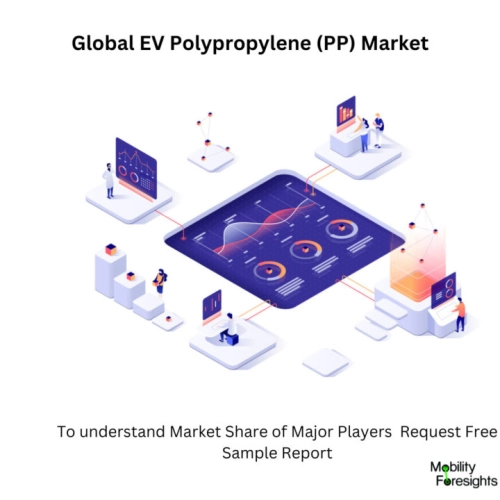
- Get in Touch with Us

Last Updated: Apr 26, 2025 | Study Period: 2023-2030
Propylene monomers are combined to create the thermoplastic "addition polymer" known as polypropylene (PP). It is employed in many different fields, such as textiles, plastic parts for the automobile sector, textile packaging for consumer goods, and special devices like live hinges.
The molecular weight and molecular weight distribution, crystallinity, type and amount of comonomer (if employed), and isotacticity of polypropylene all affect its characteristics.
For instance, the methyl groups in isotactic polypropylene are orientated to one side of the carbon backbone. In comparison to atactic polypropylene and polyethylene, this arrangement produces a stronger material with a higher degree of crystallinity.
Thermoplastic polymer polypropylene (PP), commonly referred to as polypropene, is employed in a wide range of applications. It is created from the monomer propylene using chain-growth polymerization.
Polypropylene is a non-polar, partly crystalline member of the polyolefin family. Although it is a little harder and more heat-resistant than polyethylene, its characteristics are similar.
It is a white, strong mechanical material with a high level of chemical resistance. In many ways, polypropylene and polyethylene are similar, particularly in terms of solution behaviour and electrical characteristics. While the chemical resistance declines, the methyl group enhances mechanical and thermal resistance.
Polymerized propylene is used to create the synthetic resin known as polypropylene. Polypropylene, a significant member of the polyolefin resin family, is molded or extruded into a wide variety of plastic goods when toughness, flexibility, light weight, and heat resistance are required.
Additionally, it is spun into fibers for use in household and commercial fabrics. Ethylene and propylene can be polymerized together to create an elastic copolymer. Ethane, propane, butane, and the naphtha portion of petroleum are all thermally cracked to produce the gaseous molecule known as propylene.
It is a member of the "lower olefins," a group of hydrocarbons that includes compounds with just one pair of carbon atoms connected by a double bond. Ethylene is one of these compounds.

The Global EV Polypropylene (PP) market accountedfor $XX Billion in 2021 and is anticipated to reach $XX Billion by 2030, registering a CAGR of XX% from 2022 to 2030.
The Novolen PPure polypropylene (PP) portfolio, a new grade-range of polymers suitable for supporting the production of high-quality products for automotive, healthcare components, and food packaging materials, has been launched by Lummus Technology, a global provider of process technologies and value-driven energy solutions.
By producing an improved hydrogen reaction with the catalyst, the new non-phthalate process technique offers significant energy savings. The PPure technology portfolio offers a number of variations suitable for the process and end product requirements of an operator.
High crystallinity homopolymers, ethylene random copolymers, and advanced impact copolymers are among the grades found in PPure.The injection moulding, thermoforming, raffia, cast film, and compounding applications are all suitable for the high-crystallinity homopolymers.
The two new short-glass fiber-reinforced polypropylene (PP) compounds, G3430X and G3440X grades, from SABIC, a global leader in the chemical industry, offer improved performance and processing for demanding automobile under-hood, exterior, and interior applications.
In terms of melt flow, tensile and flexural strength, and flexural modulus, the two advanced grades outperform high-performing conventional short-glass fiber composites.
Customers now have new chances to improve the performance of automobile structural components including brackets, seat constructions, and center consoles thanks to SABIC PP compound G3430X and G3440X grades. Both materials can be utilized to create parts with lower mass and weight due to their ability to form thin walls.
| Sl no | Topic |
| 1 | Market Segmentation |
| 2 | Scope of the report |
| 3 | Abbreviations |
| 4 | Research Methodology |
| 5 | Executive Summary |
| 6 | Introduction |
| 7 | Insights from Industry stakeholders |
| 8 | Cost breakdown of Product by sub-components and average profit margin |
| 9 | Disruptive innovation in the Industry |
| 10 | Technology trends in the Industry |
| 11 | Consumer trends in the industry |
| 12 | Recent Production Milestones |
| 13 | Component Manufacturing in US, EU and China |
| 14 | COVID-19 impact on overall market |
| 15 | COVID-19 impact on Production of components |
| 16 | COVID-19 impact on Point of sale |
| 17 | Market Segmentation, Dynamics and Forecast by Geography, 2023-2030 |
| 18 | Market Segmentation, Dynamics and Forecast by Product Type, 2023-2030 |
| 19 | Market Segmentation, Dynamics and Forecast by Application, 2023-2030 |
| 20 | Market Segmentation, Dynamics and Forecast by End use, 2023-2030 |
| 21 | Product installation rate by OEM, 2023 |
| 22 | Incline/Decline in Average B-2-B selling price in past 5 years |
| 23 | Competition from substitute products |
| 24 | Gross margin and average profitability of suppliers |
| 25 | New product development in past 12 months |
| 26 | M&A in past 12 months |
| 27 | Growth strategy of leading players |
| 28 | Market share of vendors, 2023 |
| 29 | Company Profiles |
| 30 | Unmet needs and opportunity for new suppliers |
| 31 | Conclusion |
| 32 | Appendix |